MAPS: The places in Spain which are most at risk of recurring flash floods

Homeowners and property hunters in Spain rarely factor in flood risks until tragedy strikes, even though there are parts of the country which are more exposed to being destroyed by torrential rain and ensuing flash floods.
In Spain there are 977,000 people who live with the risk of their homes being affected by floods.
That’s according to Spain’s Sustainability Observatory, which forms part of Spain’s General Council of the Associations of Insurance Mediators, a body which is understandably focused on alleviating the cost of millions if not billions of euros of damage every time there are flash floods in the country.
Their 2019 study found that almost a million people living within 10 kilometres of the Spanish coastline were at risk of having their properties destroyed and their lives put at risk, factoring in the probability of flooding caused by torrential rains, cyclones or storms, but not by rising sea levels, which in itself also poses a great risk to many coastal cities and towns in Spain.
READ MORE: The Spanish cities that will be most affected by rising sea levels
Experts estimate around 50,000 properties in Spain are built in areas that are at risk of recurring floods.
Which parts of Spain are most at risk of flooding?
It was with good reason that the study by Spain’s Sustainability Observatory focused only on the Spanish coastline as this is the area which is most exposed to heavy rainfall causing flash floods.
The three regions in Spain where most people will be affected by flash floods in the coming years based on previous floods and ongoing overdevelopment are the Valencia region (380,000 people affected), Catalonia (190,000) and Andalusia (130,000).
Valencia, Cádiz and Girona are the provinces that are most at risk of inundaciones (floods).
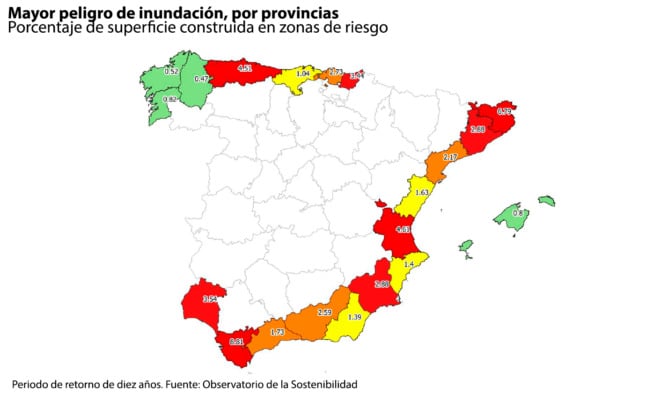
Map showing the provinces in Spain which are most at risk of suffering severe floods. Source: Sustainability Observatory
Spain’s Sustainability Observatory also looked in more detail at specific areas of the Spanish coastline where homeowners have to be aware they are particularly exposed to floods:
- Isla Cristina-Ayamonte (Huelva)
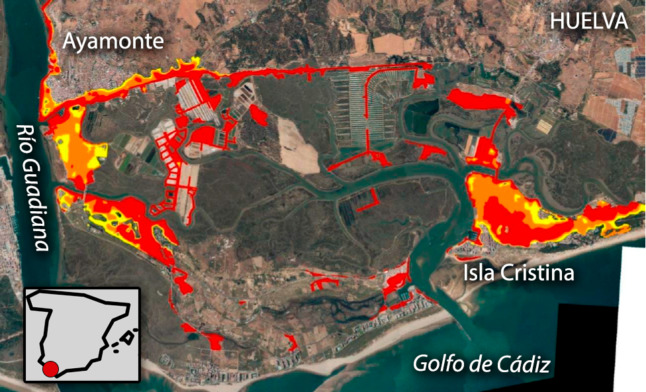
- Palmones-Guadarranque (Cádiz)
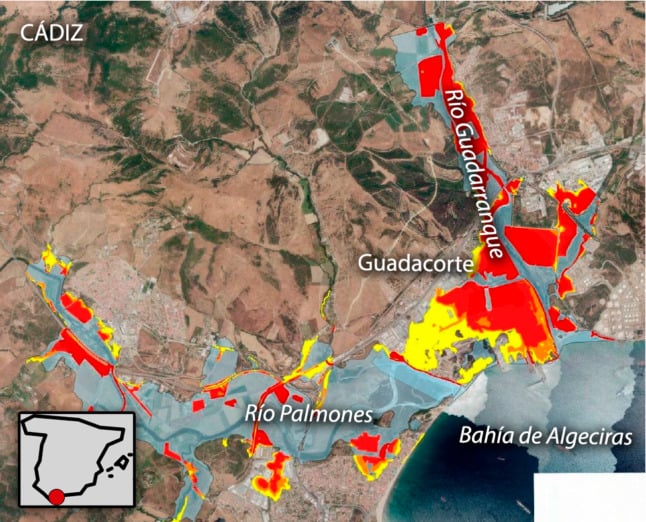
- Bajo Guadalhorce (Málaga)
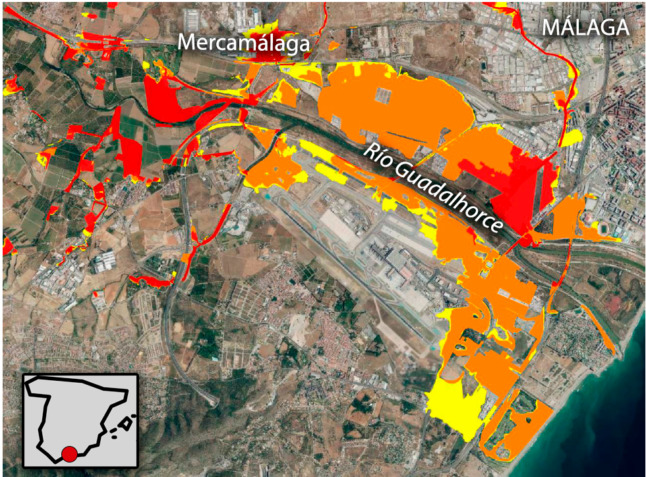
- Bajo Andarax (Almería)
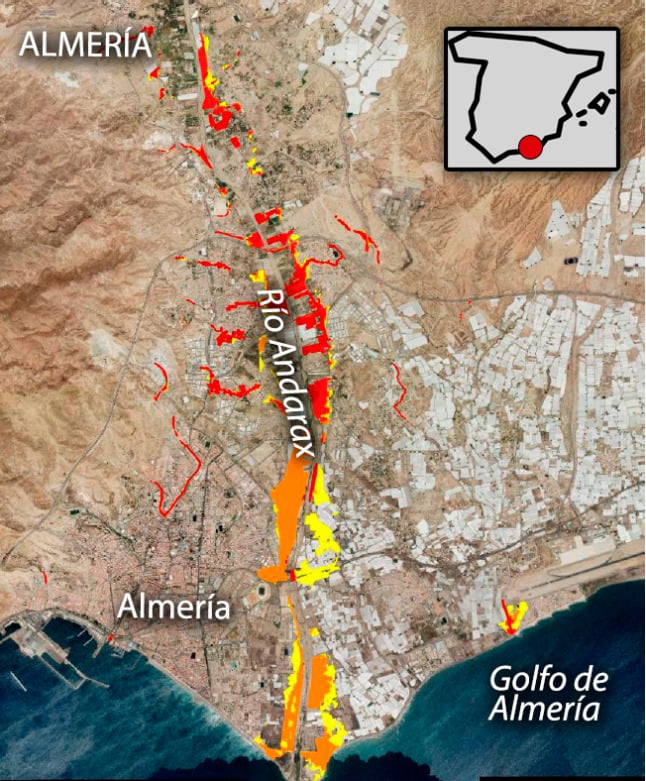
- Cartagena (Murcia)
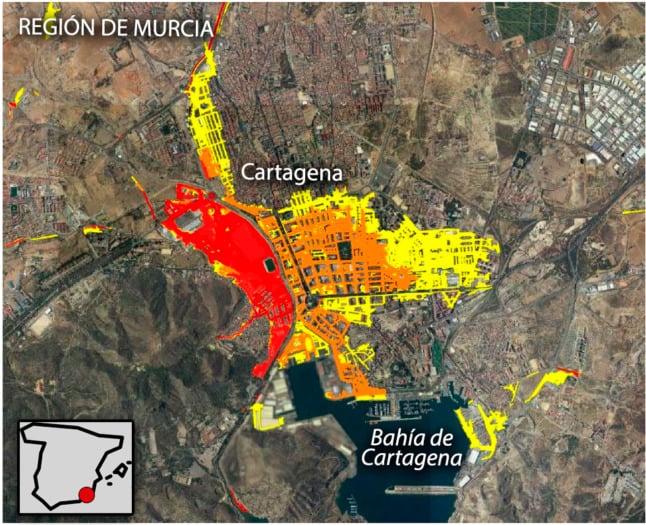
- San Javier-Los Alcázares (Murcia)
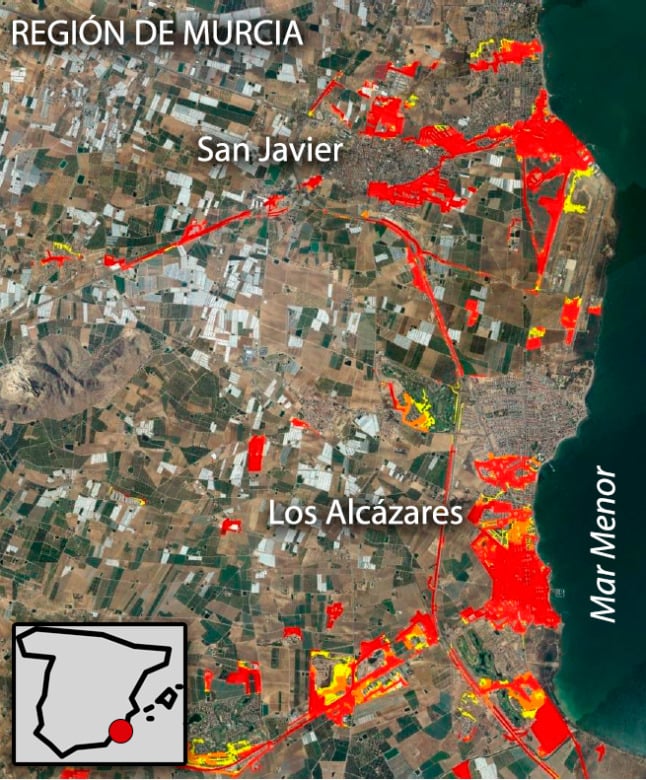
- Costa de Marina Alta (Alicante)
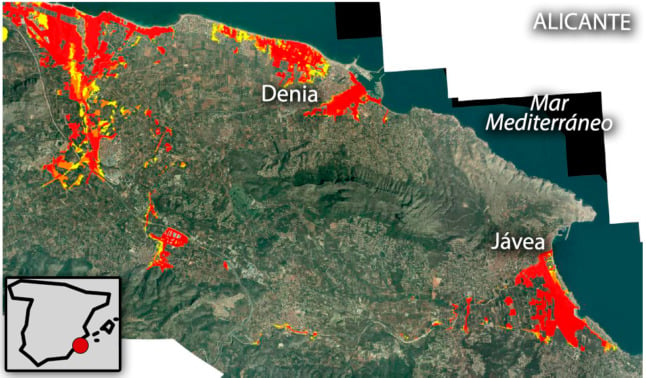
- Gandía-Oliva (Valencia)
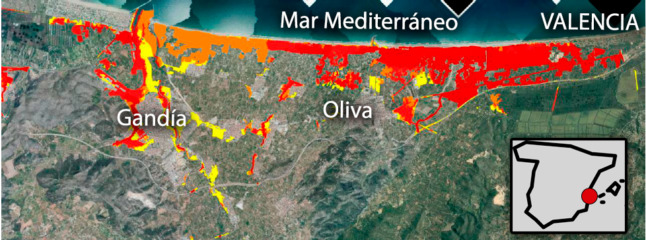
- Alaquas-Catarroja (Valencia)
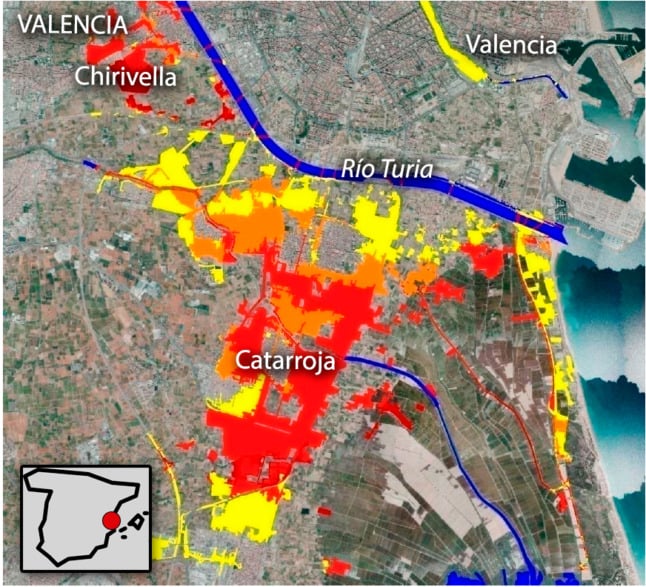
- Vinaroz-Peñíscola (Castellón)

- Empuribrava-Santa Margarida (Girona)
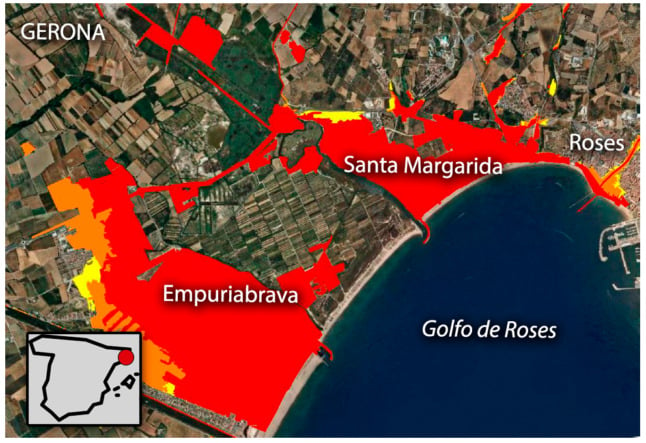
- Palma de Mallorca (Balearic Islands)
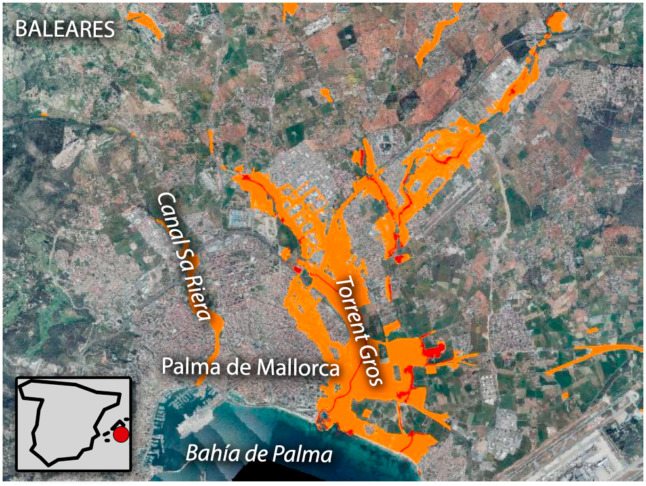
- Gijón (Asturias)
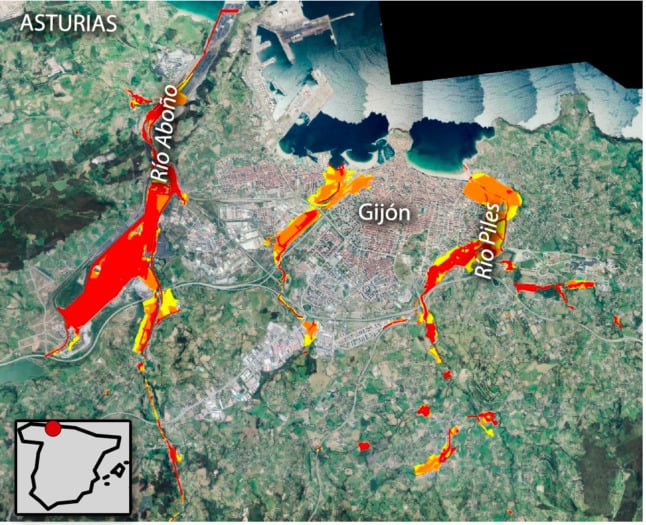
- Bajo Urumea (Guipúzcoa)
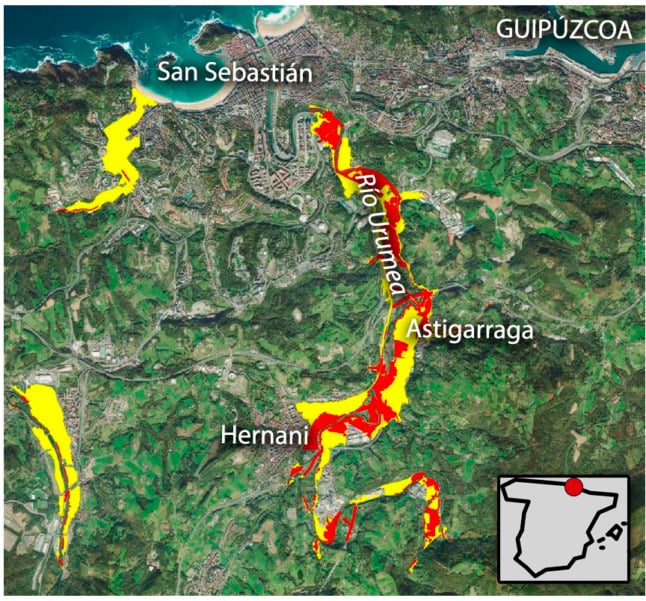
Although not included on the list, the Murcian town of Águilas has suffered severe flooding in March and September 2021 as well as in 2019.
Is it only coastal areas that are at risk of floods in Spain?
Not at all. As seen in early September 2021, heavy rainfall caused plenty of destruction in the municipalities of Cobisa, Argés and Polán in Toledo province, in inland Spain.
Most of the affected properties were built on dried up riverbeds that overflowed with the heavy rainfall, sweeping away pretty much everything in its path. In Cobisa’s case, homes erected on the dried up stream from the river Tagus saw flooding so powerful it broke down the walls of homes.
Historically speaking, the areas most exposed to this type of flood have been those close to the rivers Duero, Guadalquivir and Ebro.
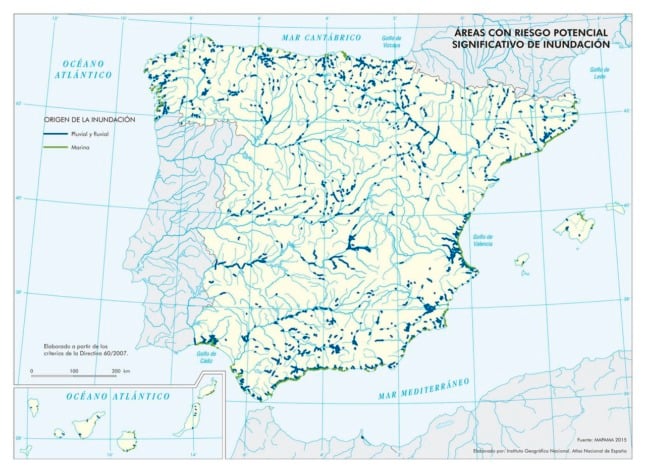
2015 map by Spain's Ministry of Development showing areas across Spain (including the interior) which are most of risk of serious flooding.
How do I find out if my Spanish property is built in a flood risk area?
Aside from asking neighbours or doing some research online, you should also be able to request the information at the town hall.
There’s also this interactive map by Spain’s Flood Zone Cartography System (SNCZI) which allows users to zoom in to a particular area to find out if they live close to a dried up riverbed.
Two other useful sources are Spain’s National Catalog of Historical Floods (which hasn’t been updated in several years) and Spain’s General Directorate of Civil Protection and Emergencies (DGPCyE).
According to environmentalist Fernando Prieto at Spain’s Sustainability Observatory, regional authorities should do more to inform people about the risk of floods in their area.
“Local authorities should send out a text or WhatsApp message to all local residents warning them of the torrential rain and flooding that’s about to take place,” Prieto told TV channel La Sexta.
“Another idea that could be implemented is for properties to have a flood risk certificate - just as we have certificates of energy efficiency in Spain - which states the risk of flooding a property has, so people can prepare or even know before buying a home.
Should I factor in the flood risk when buying a property in Spain?
Yes, it’s better to be safe than sorry, especially if you’re looking at properties in built-up coastal areas.
The first step is to find out if the area where the building is located has experienced flooding in the past . If so, you will have to ask the following questions:
- How many floods have occurred in recent years?
- What was the level reached by the water in that area?
- What kind of flood was it?
- Is the property currently protected by flood defences?
Knowing the answers to the following questions will help you analyse the danger to which your property or potential property is exposed.
You’ll know the extent of the flood zone, the frequency of flooding by return period or the number of times it has historically been flooded, potential height of the water reaching the building and the speed that the water will flow in the event of a flash flood.
Also, if you want to dig deeper for information, find out:
- Is the building near a river, stream or canal?
- Are you at the bottom of a valley or floodplain?
- Is it near the sea?
- Are you in an area endangered by groundwater flooding?
- Are you near a surface water drainage area or stream that could overflow?
- Is it at a low point in the territory?
- Is it protected by river or coastal defences?
- Has the property or surrounding grounds and gardens ever been flooded in the past?
- Have neighbouring properties been flooded?
- Has a flood warning been issued in the vicinity of the property?
If the answer to almost all of these questions is no, then the risk of flooding to your property in Spain should be minimal.
Comments
See Also
In Spain there are 977,000 people who live with the risk of their homes being affected by floods.
That’s according to Spain’s Sustainability Observatory, which forms part of Spain’s General Council of the Associations of Insurance Mediators, a body which is understandably focused on alleviating the cost of millions if not billions of euros of damage every time there are flash floods in the country.
Their 2019 study found that almost a million people living within 10 kilometres of the Spanish coastline were at risk of having their properties destroyed and their lives put at risk, factoring in the probability of flooding caused by torrential rains, cyclones or storms, but not by rising sea levels, which in itself also poses a great risk to many coastal cities and towns in Spain.
READ MORE: The Spanish cities that will be most affected by rising sea levels
Experts estimate around 50,000 properties in Spain are built in areas that are at risk of recurring floods.
Which parts of Spain are most at risk of flooding?
It was with good reason that the study by Spain’s Sustainability Observatory focused only on the Spanish coastline as this is the area which is most exposed to heavy rainfall causing flash floods.
The three regions in Spain where most people will be affected by flash floods in the coming years based on previous floods and ongoing overdevelopment are the Valencia region (380,000 people affected), Catalonia (190,000) and Andalusia (130,000).
Valencia, Cádiz and Girona are the provinces that are most at risk of inundaciones (floods).

Map showing the provinces in Spain which are most at risk of suffering severe floods. Source: Sustainability Observatory
Spain’s Sustainability Observatory also looked in more detail at specific areas of the Spanish coastline where homeowners have to be aware they are particularly exposed to floods:
- Isla Cristina-Ayamonte (Huelva)

- Palmones-Guadarranque (Cádiz)

- Bajo Guadalhorce (Málaga)

- Bajo Andarax (Almería)

- Cartagena (Murcia)

- San Javier-Los Alcázares (Murcia)

- Costa de Marina Alta (Alicante)

- Gandía-Oliva (Valencia)

- Alaquas-Catarroja (Valencia)

- Vinaroz-Peñíscola (Castellón)

- Empuribrava-Santa Margarida (Girona)

- Palma de Mallorca (Balearic Islands)

- Gijón (Asturias)

- Bajo Urumea (Guipúzcoa)

Although not included on the list, the Murcian town of Águilas has suffered severe flooding in March and September 2021 as well as in 2019.
Is it only coastal areas that are at risk of floods in Spain?
Not at all. As seen in early September 2021, heavy rainfall caused plenty of destruction in the municipalities of Cobisa, Argés and Polán in Toledo province, in inland Spain.
Most of the affected properties were built on dried up riverbeds that overflowed with the heavy rainfall, sweeping away pretty much everything in its path. In Cobisa’s case, homes erected on the dried up stream from the river Tagus saw flooding so powerful it broke down the walls of homes.
Historically speaking, the areas most exposed to this type of flood have been those close to the rivers Duero, Guadalquivir and Ebro.

2015 map by Spain's Ministry of Development showing areas across Spain (including the interior) which are most of risk of serious flooding.
How do I find out if my Spanish property is built in a flood risk area?
Aside from asking neighbours or doing some research online, you should also be able to request the information at the town hall.
There’s also this interactive map by Spain’s Flood Zone Cartography System (SNCZI) which allows users to zoom in to a particular area to find out if they live close to a dried up riverbed.
Two other useful sources are Spain’s National Catalog of Historical Floods (which hasn’t been updated in several years) and Spain’s General Directorate of Civil Protection and Emergencies (DGPCyE).
According to environmentalist Fernando Prieto at Spain’s Sustainability Observatory, regional authorities should do more to inform people about the risk of floods in their area.
“Local authorities should send out a text or WhatsApp message to all local residents warning them of the torrential rain and flooding that’s about to take place,” Prieto told TV channel La Sexta.
“Another idea that could be implemented is for properties to have a flood risk certificate - just as we have certificates of energy efficiency in Spain - which states the risk of flooding a property has, so people can prepare or even know before buying a home.
Should I factor in the flood risk when buying a property in Spain?
Yes, it’s better to be safe than sorry, especially if you’re looking at properties in built-up coastal areas.
The first step is to find out if the area where the building is located has experienced flooding in the past . If so, you will have to ask the following questions:
- How many floods have occurred in recent years?
- What was the level reached by the water in that area?
- What kind of flood was it?
- Is the property currently protected by flood defences?
Knowing the answers to the following questions will help you analyse the danger to which your property or potential property is exposed.
You’ll know the extent of the flood zone, the frequency of flooding by return period or the number of times it has historically been flooded, potential height of the water reaching the building and the speed that the water will flow in the event of a flash flood.
Also, if you want to dig deeper for information, find out:
- Is the building near a river, stream or canal?
- Are you at the bottom of a valley or floodplain?
- Is it near the sea?
- Are you in an area endangered by groundwater flooding?
- Are you near a surface water drainage area or stream that could overflow?
- Is it at a low point in the territory?
- Is it protected by river or coastal defences?
- Has the property or surrounding grounds and gardens ever been flooded in the past?
- Have neighbouring properties been flooded?
- Has a flood warning been issued in the vicinity of the property?
If the answer to almost all of these questions is no, then the risk of flooding to your property in Spain should be minimal.
Join the conversation in our comments section below. Share your own views and experience and if you have a question or suggestion for our journalists then email us at [email protected].
Please keep comments civil, constructive and on topic – and make sure to read our terms of use before getting involved.
Please log in here to leave a comment.